Fender American Acoustasonic Stratocaster vs PRS SE Hollowbody II Piezo
Looking for a bit of acoustic tone from your electric? We review two 2020 examples of a hybrid genre for stage and studio use
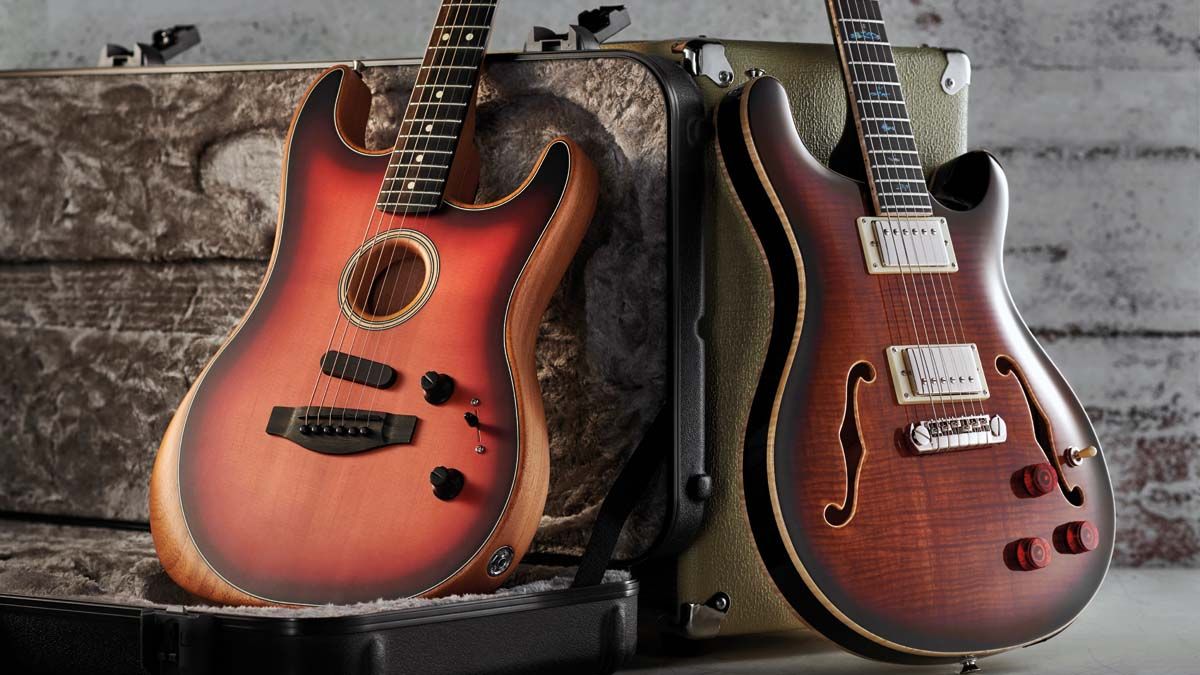
It could easily be argued that while the electric guitar seems hampered by its past, one of the truly innovative paths in the past three decades has been to add acoustic-like sounds turning the electric guitar into an electric/acoustic hybrid.
Although efforts appeared a lot earlier, this type of hybrid came to the fore in the 90s with guitars such as Hamer’s DuoTone and Parker’s Fly illustrating two very different ways of creating this duality.
We’ve seen this trend peak and trough over the subsequent years with numerous brands usually offering piezo acoustic sounds on distinct models or simply as an option.
As those mid-90s designs showed us, there is definitely more than one way to skin this sonic cat.
Hamer’s DuoTone was effectively a solidbody-sized thinline acoustic with a braced spruce top and acoustic bridge. It was powered by a pretty conventional piezo under-saddle transducer for its acoustic sound and a pair of humbuckers for its regular magnetic pickup electric sound.
The Parker Fly, one of the most radical designs in the history of the instrument, was a solidbody electric with regular magnetic pickups and its acoustic voice came from individual piezo elements, mounted in its vibrato bridge and designed by Larry Fishman.
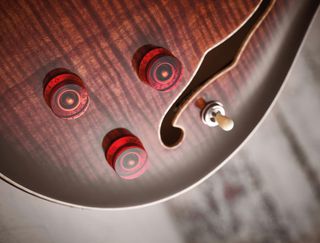
On review here we have two radically different yet very mainstream hybrids, both released this year. Now, we looked at the Fender USA’s Acoustasonic Stratocaster back in issue 458: a solidbody-sized acoustic with complex electronics (again created by Larry Fishman’s team) with a couple of magnetic electric sounds.
Get The Pick Newsletter
All the latest guitar news, interviews, lessons, reviews, deals and more, direct to your inbox!
That’s in sharp contrast to the brand-new PRS SE Hollowbody II Piezo. The Chinese-made SE Hollowbody II and lower-priced Standard appeared at the end of 2019 (we looked at both back in issue 456) but this new Piezo version launched mid-year.
It’s effectively a slightly souped-up version with a piezo system that’s designed in conjunction with LR Baggs, like PRS’s long running piezo option for its USA Hollowbody.
Where both models score is in their ability to blend between electric and acoustic in a single instrument
So, two very different ways of taking on the electric/acoustic challenge and a battle of styles, too, in terms of the ways they are achieved by the two leading lights in acoustic guitar transducer and amplification technology: Fishman and LR Baggs.
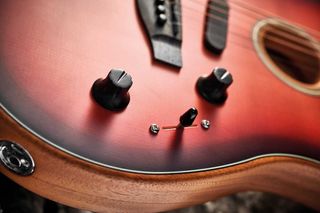
Setting The Scene
It’s not our intention to re-review either guitar. Instead, it’s the acoustic sound and how it’s implemented with the magnetic electric voices that we want to focus on here. Fender’s Acoustasonic platform launched in 2019 with the Telecaster version of this 2020 Stratocaster model. Along with their shapes, they’re a little different in terms of the sounds they offer.
But both Acoustasonics shoot for a much more acoustic-like experience from a solidbody-sized platform, and instead of offering one acoustic sound – like the PRS – we have a host of digitally achieved acoustic sounds accessed from the five-way lever Voice Selector switch and the rotary Mod knob, which allows you to morph the sound pairs or add a little grit to the lone magnetic pickup in front of the bridge.
PRS’s USA-made Hollowbody models date back to the late 90s and were the first platform for the co-designed piezo system. Other more solidbody piezo-equipped PRSes have been and gone over the years and today there’s just the solidbody Custom 22 and 24 Piezo models augmenting the single piezo-loaded Hollowbody II in the line-up. As ever, they’re not cheap.
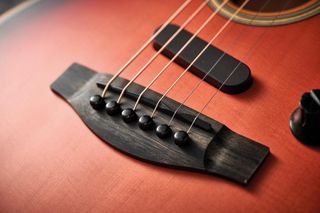
But as you’ll know, the SE range is about affordability and the SE Hollowbody models, made in the same Chinese factory PRS uses for its start-up acoustic range, combine an old-school laminate construction that’s mainly hollow with a block under the bridge connecting top to back.
This new Piezo version is identical to the earlier SE Hollowbody II save for some subtly upgraded cosmetics – figured maple binding instead of cream plastic and posher multi-coloured shell bird inlays as opposed to just pearloid – and, of course, the piezo addition.
So, in contrast to the Acoustasonic, we have a fully functioning dual-humbucking electric ‘semi’ that you can switch to acoustic-only or blend that sound with either or both magnetic pickups.
Price wise, bearing in mind where they’re made, there’s not a huge disparity. The Acoustasonic is available in more colours and comes with a deluxe gigbag, the PRS comes with a case – although neither caters for our left-handed friends.
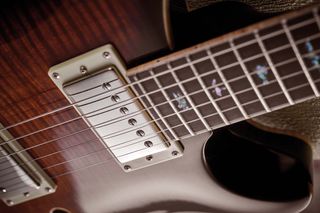
In Use
The Acoustasonic is Strat-sized, a rather beautiful design that is effectively an acoustic guitar with a braced spruce top. Its central soundhole, or ‘doughnut’ as it’s known, acts as a soundport and creates quite an intimate acoustic voice unplugged that’s ideal for practice, songwriting or simply sofa noodling.
It does have an acoustic-style bridge and is strung with acoustic strings, so despite its size and shape, it’s an acoustic first and an electric second. The SE Hollowbody is a complete redesign of the original PRS Hollowbody.
As we said, unlike the USA version that’s hollowed out from solid wood, the SE version is laminate maple (with solid mahogany sides): the top and back are pressed into shape like the classic semis from Gibson and Gretsch, for example.
It’s a bigger proposition, too – 356mm (14 inches) across its lower bouts as opposed to 330mm (13 inches) of the original USA Hollowbody – and its primarily hollow nature means there’s a pretty classic, almost archtop-like snappy voice unplugged: not enough to cut through a small acoustic combo perhaps but more than enough for personal playing and practice, like the Acoustasonic.
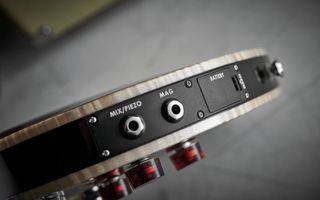
The Strat’s length is classic Fender at 648mm (25.5 inches); the PRS sticks to its original 635mm (25-inch) scale. The Strat ships with Fender Dura-Tone 860CL coated phosphor bronze (0.011 to 0.052) acoustic strings and we restrung ours with Elixir Nanoweb-coated phosphor bronze Custom Lights of the same gauge; both sets use a wound third string.
The SE drops down to 0.010 to 0.046-gauge uncoated electric PRS strings with an unwound third string. So, even though the setups are pretty similar in terms of string height, the feel is dramatically different.
Despite the Strat’s shape and deep ‘C’ neck profile – the same as Fender’s USA Professional but with a 305mm (12-inch) ’board radius – the almost bare wood finish and those acoustic strings are in stark contrast to the PRS. Here we have a bigger neck profile, gloss finish and a regular 254mm (10-inch) fingerboard radius. Kind of chalk and cheese.
Power & Outputs
Unlike the time-honoured passive electric guitars, anything with an active circuit needs powering so if you’re battery-phobic bear this in mind. The Fender’s circuity is powered by a rechargeable battery in a very modern fashion via a small USB socket on the circular output jack: when the small LED turns green you’re up to full power. There are no battery or access plates to remove.
The PRS SE is more traditional: it uses a standard block style nine-volt battery accessed simply by a clip-off cover on the instrument’s side. However, as PRS explains, “when using the magnetic output jack in isolation, the piezo battery is bypassed completely, acting as a failsafe. In this scenario, the magnetic pickups still work even if the piezo battery has run out of juice.”
There is nothing acoustic-like in the PRS build, so what we’re hearing is mightily impressive
Our Fender has just one output. The PRS has two marked Mix/Piezo and Mag; you use the former with a single jack lead to run both electric and acoustic into a single amp. If you want to run the two sides into different amp destinations simultaneously, you use both. So you might send the piezo to an acoustic amp or the PA while you send the regular electric output to your combo.
Controls on the PRS are very traditional, with a volume and tone for the magnetic pickups and just a volume for the piezo output
The Fender can’t therefore voice both its acoustic and electric sounds simultaneously; the PRS can. That said, in position 2 on the Acoustasonic’s Voice Selector the sound pair is a dreadnought and the clean magnetic pickup, which you can blend with the Mod knob.
Controls on the PRS are very traditional, too, with a volume and tone for the magnetic pickups and just a volume for the piezo output. Unlike the USA piezo system there’s no ‘mode’ mini-toggle thatselects mag/mag and piezo/piezo.
From experience in using this in a live setting, this writer has to say that it can get in the way and be easily knocked, especially as you adjust the master volume control. The SE, then, comes across as a little more straightforward and intuitive to drive.
Acoustic Sounds
So, can you really get an electric guitar to sound like an acoustic? Using our gigging acoustic pedalboard with an LR Baggs Venue DI at its heart running into our AER Compact 60 we start with PRS’s SE.
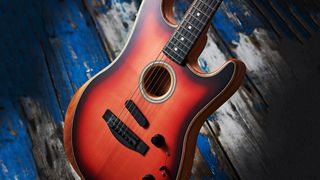
A recap of the Acoustasonic’s sounds
There’s plenty to listen to on the Acoustasonic Strat. Starting in ‘neck pickup position’, position 5 of the Voice Selector switch, we have what Fender calls its Core Acoustics: a Sitka spruce-topped dreadnought with mahogany back and sides (A); turn the Mod control clockwise and we voice sound B, a smaller slothead Sitka spruce-topped concert with rosewood back and sides.
Position 4 offers the Alternative Acoustics, a short-scale guitar with Sitka spruce top and walnut back and sides (A) and a Sitka spruce/mahogany Americana dreadnought (B).
Position 3 is Percussion & Enhanced Harmonics where a single voice, a Sitka spruce-topped Auditorium size with rosewood back and sides (A), can be blended with the top pickup (B).
Position 2 Acoustic & Electric Blend has an Englemann spruce-topped dreadnought with rosewood back and sides (A) and the magnetic Fender electric clean pickup (B).
Finally, position 1 is fully electric, that same magnetic pickup with but ‘fat/semi clean’ and a little extra crunch (A) and then the same with more gain, Fender Electric Dirty (B).
On its own it sounds like a credible acoustic-y voice with a pretty much total lack of piezo ‘quack’. Not only would that get you through the one acoustic number in your rockier electric set but it doesn’t sound like a posh acoustic guitar with a posh mic in front of it – and that’s not a criticism.
It can sometimes be hard to tame down the bite and attack of even a good-sounding expensive electro in a stage setting, not least a band setting, and a royal pain to swap from your ES-335 to your 000. So, bearing in mind that there is nothing acoustic-like in the build of the guitar we’re playing, what we’re hearing is mightily impressive. But does the SE really nail an accurate ‘acoustic’ sound? And how can it?
Well, that is where our Acoustasonic Stratocaster comes in. This is quite a different ‘acoustic’. Its various voices are worth a recap (again, see the box on the right here) but plugged into the same signal path we’re hearing a much more acoustic-like voice. Or indeed voices.
As we concluded in our original review, we’ve not heard anything close to this good from such a small-bodied instrument. If the real amplified acoustic experience is what you’re after, this writer’s favourite sound is probably on position 3 of the five-way, blending in the top pickup.
Electric & Beyond
The majority of electric/acoustic hybrids we’ve explored in the past simply add a piezo acoustic voice to a semi or a solidbody more often than not. That’s the deal with this PRS model, and even if you rarely use the acoustic sound you have a cracking electric.
And while this test is primarily centred on the new piezo voice, we have to remind you what a well-sorted electric guitar this is. The 58/15 ‘S’ pickups are USA designed and made in Indonesia – and they really suit the guitar. Stopping short of high stage-volume hard-rock and metal, they can pretty much cover any base that you’d expect from a relatively low-output twin-humbucker semi.
The plummy jazz sounds are stellar, the neck pickup alone has clarity and depth in abundance, the mix has that classic funk with a little more brightness, and even the bridge pickup adds a little more steely clarity that doesn’t sound jarring in the least.
By design, the Acoustasonic Strat is acoustic first, electric second, but it’s far from just an afterthought
Using the mixed mono output – still running into our acoustic signal chain – the SE is really easy to use with the dedicated volumes allowing you to mix on the fly. Mix in a hint of the neck or both pickups with the acoustic-y edge of the piezo and this is where the money lies for many.
Conversely, adding a slightly stringier character to that neck pickup ‘jazz’ tone really works, too. We couldn’t compare the SE with a 2020 Core Hollowbody but our well-used all-mahogany Singlecut Hollowbody with the original PRS piezo system provides some comparison. Here the SE’s voice is a little more strident, brighter; the older USA model is a little more refined and mellow but remarkably similar in character.
By design, the Acoustasonic Strat is acoustic first, electric second, but it’s far from just an afterthought. While you can’t send the output to two separate amps, in position 2 of the Acousticaster’s five-way you can blend the clean bridge magnetic pickup with a dreadnought – another favourite – and this sort of adds a steely smoothness to the acoustic voice.
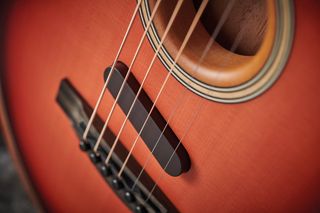
In position 1 we can access the same magnetic sound with a little crunch and then more. A simple A/B/Y splitter proves very handy during this test and we switch effortlessly from rootsy acoustic through our acoustic signal path to surprisingly useful quite fat Tele-ish, almost hollow-body-like tones from our electric amp.
In that latter scenario the Strat’s volume control works like a regular electric to pull back the crunch or vice versa. It’s very much its own sound, though, and suits the whole rootsy Americana flavour perfectly. The string gauge and setup make slide playing a dream, too.
Of course, you don’t have to solely run the acoustic side of either guitar into an acoustic amp or PA. There are some great sounds to be had with it running into a crunchy amp voice, not to mention your usual pedalboard as well.
Verdict
For the gigging or recording musician wanting to create both electric and acoustic voices from the same instrument, live or for your recording projects, these are two state-of-the-art though very different solutions.
This new Piezo version of the SE Hollowbody II comes fast on the heels of PRS’s recently released non-piezo model – a fact that might disappoint anyone who’s just purchased one.
Spending some more time with the Acoustasonic Strat, we’re reminded just what a leap forward it is in terms of the accurate mic’d acoustic sounds it provides
Aside from the minor cosmetic upgrade, of course, there is no build difference but there’s little doubt the Piezo model considerably expands the sonic potential, making a very good guitar quite exceptional.
Spending some more time with the Acoustasonic Strat, however, we’re reminded just what a leap forward it is in terms of the accurate mic’d acoustic sounds it provides – with enough ‘electric’ to begin to blur the lines.
It would still be our choice if you need acoustic first from what is essentially a solidbody-sized package. But it doesn’t have the do-it-all attraction of the PRS SE and guitars like it, particularly if you use your neck pickup.
But where both of these models score is in their ability to blend between electric and acoustic in a single instrument, in turn creating some genuinely new sounds and textures. Here’s proof – in two guises – that innovation can certainly play a part in modern guitar design.
Fender American Acoustasonic Stratocaster
PROS It’s Strat-shaped but the likeness ends there: an innovative design with superb ‘mic’d acoustic’ sounds and great magnetic voice
CONS The acoustic strings might limit its crossover appeal; no lefties
4.5/5
PRS SE Hollowbody II Piezo
PROS Typical detailed build; superb neck shape and playability; the 58/15 ‘S’ humbuckers; the icing is the excellent-sounding piezo system
CONS A leap up from the non-piezo model in price; two colours; no lefties
4.5/5
Specifications
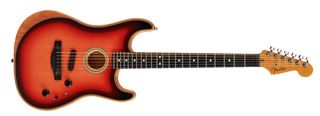
- PRICE: $1,999.99 / £1,749 (inc gigbag)
- ORIGIN: USA
- TYPE: Double-cutaway, solidbodysized electro-acoustic
- BODY: Mahogany (hollow) with inset Sitka spruce top
- NECK: Mahogany, modern ‘deep C’ profile, bolt-on
- SCALE LENGTH: 648mm (25.5”)
- TUNERS: Fender standard cast/ sealed staggered tuners
- NUT/WIDTH: Graph Tech Black Tusq/42.8mm
- FINGERBOARD: Ebony, white dot markers, 305mm (12”) radius
- FRETS: 22, narrow/tall
- BRIDGE/SPACING: Ebony w/compensated Black Tusq saddle/53.5mm
- ELECTRICS: 3-pickup configuration: Fishman under-saddle transducer and bridge plate body sensor, Fender Noiseless N4 magnetic. master volume, Mod knob, 5-way Voice Selector lever switch. Single mono output with USB battery charge
- WEIGHT (kg/lb): 2.32/5.1
- OPTIONS: Colour only
- RANGE OPTIONS: The American Acoustasonic Telecaster (£1,749)
- LEFTHANDERS: No
- FINISHES: 3-Color Sunburst (as reviewed), Black, Dakota Red, Natural, Transparent Sonic Blue – satin matt polyester to body; satin urethane to neck and headstock
- CONTACT: Fender
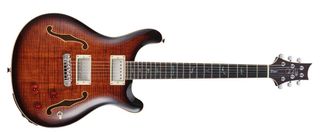
- PRICE: $1,549 / £1,349 (inc case)
- ORIGIN: China
- TYPE: Double-cut hollowbody electric
- BODY: Double figured maple bound flame maple laminate (top and back) 5-ply w/ mahogany laminate sides
- NECK: Mahogany, Wide Fat profile, glued-in
- SCALE LENGTH: 635mm (25”)
- NUT/WIDTH: Bone/43mm
- FINGERBOARD: Figured maple bound ebony, multi-coloured shell bird inlays, 254mm (10-inch) radius
- FRETS: 22, medium
- HARDWARE: PRS Adjustable Stoptail, PRS designed tuners – nickel-plated
- STRING SPACING, BRIDGE: 52.5mm
- ELECTRICS: PRS 58/15 ‘S’ Treble and Bass humbuckers, 3-way toggle pickup selector, volume and tone. LR Baggs/ PRS Piezo system with dedicated volume control. Dual Mix/Piezo and Mag outputs
- WEIGHT (kg/lb): 2.88/6.34
- RANGE OPTIONS: The non-piezo SE Hollowbody models are the II ($1,149 / £999) and the Standard ($999 / £899). USA Core level models with a similar LR Baggs/PRS piezo system include the Hollowbody II Piezo (from $4,900 / £4,749) and the Custom 22 and 24 Piezo (both from $4,050 / £3,995)
- LEFT-HANDERS: No
- FINISHES: Black Gold Burst (as reviewed), Peacock Blue Burst

Dave Burrluck is one of the world’s most experienced guitar journalists, who started writing back in the '80s for International Musician and Recording World, co-founded The Guitar Magazine and has been the Gear Reviews Editor of Guitarist magazine for the past two decades. Along the way, Dave has been the sole author of The PRS Guitar Book and The Player's Guide to Guitar Maintenance as well as contributing to numerous other books on the electric guitar. Dave is an active gigging and recording musician and still finds time to make, repair and mod guitars, not least for Guitarist’s The Mod Squad.
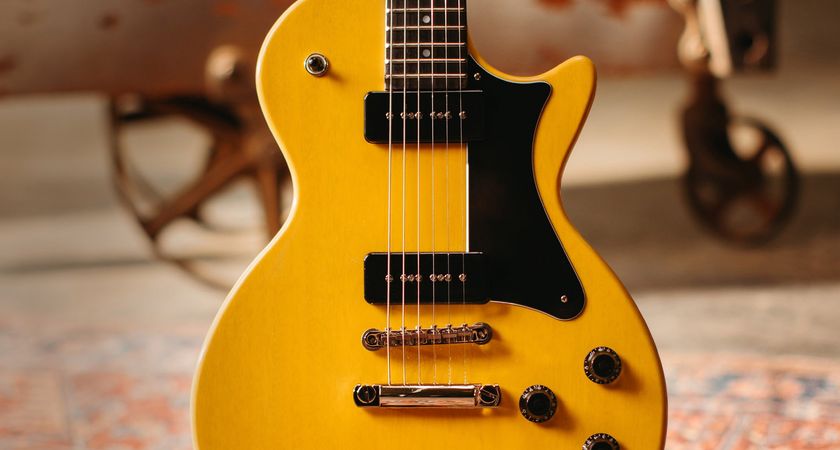
“If you’re in the market for a single-cut on steroids with vintage charm, this is the one to wield”: Heritage Guitars Custom Shop Core Collection H-137 review
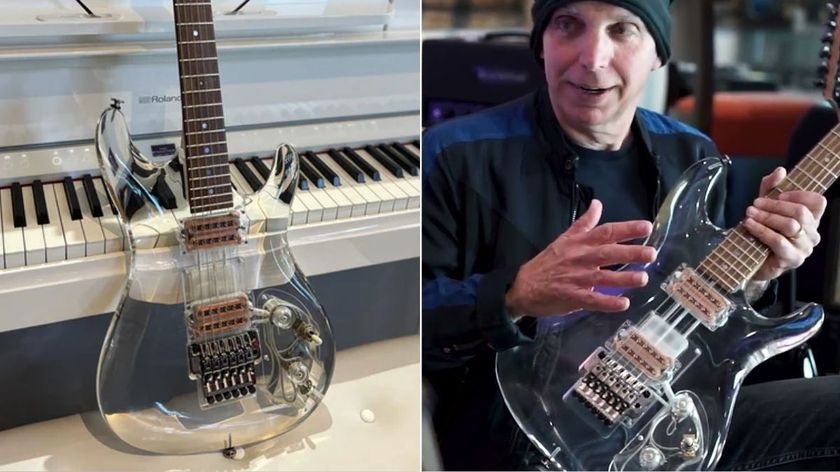
“When I saw it, I couldn’t believe how cool it was”: Joe Satriani is selling one of his rarest guitars – an ultra-ambitious Ibanez Y2K Crystal Planet prototype


![Adrian Smith [left] and Richie Kotzen pose with an HSS S-style and Telecaster respectively.](https://cdn.mos.cms.futurecdn.net/DqivbKgc2aXLoykDT3h5mN-840-80.jpg)
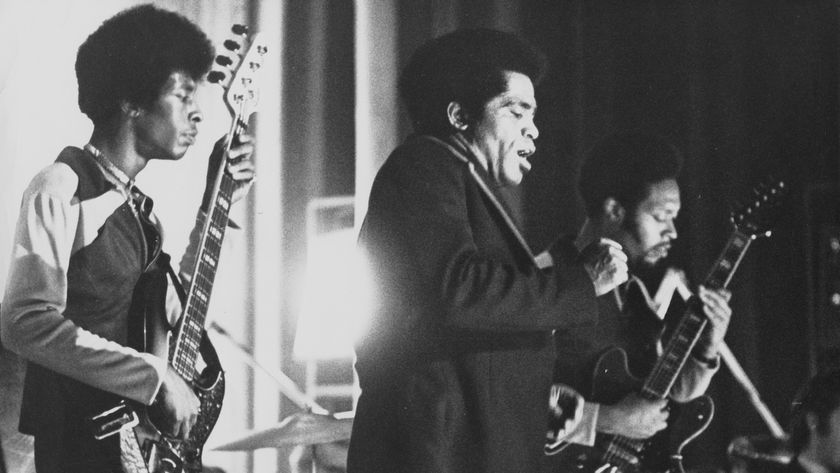

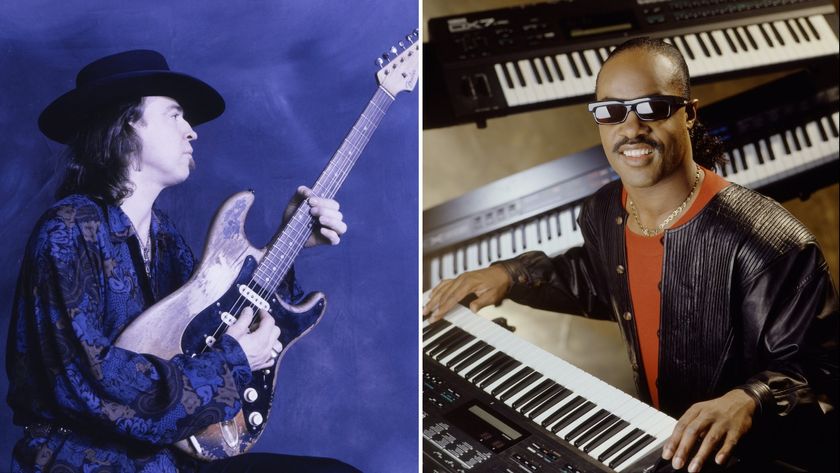


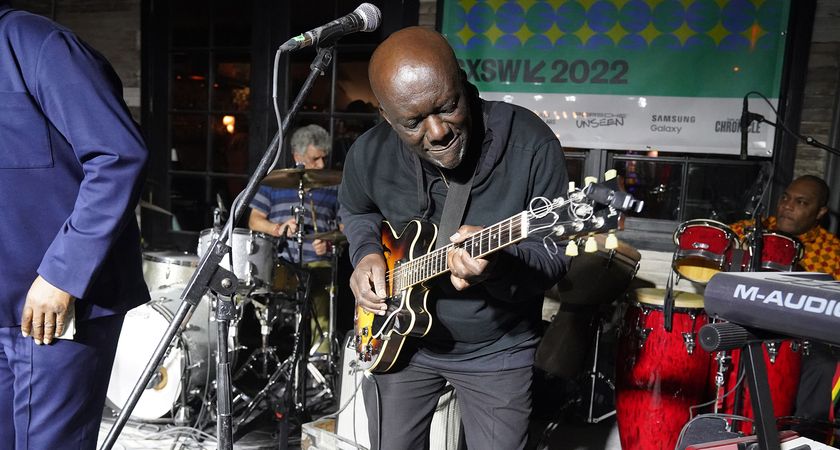
![[L-R] George Harrison, Aashish Khan and John Barham collaborate in the studio](https://cdn.mos.cms.futurecdn.net/VANJajEM56nLiJATg4P5Po-840-80.jpg)